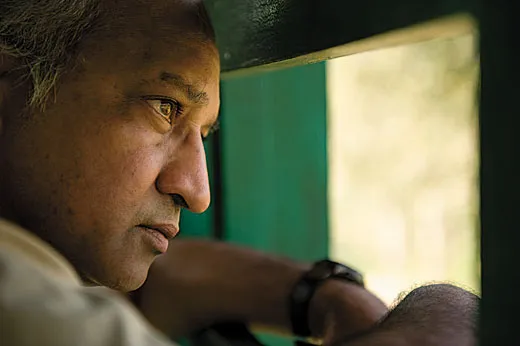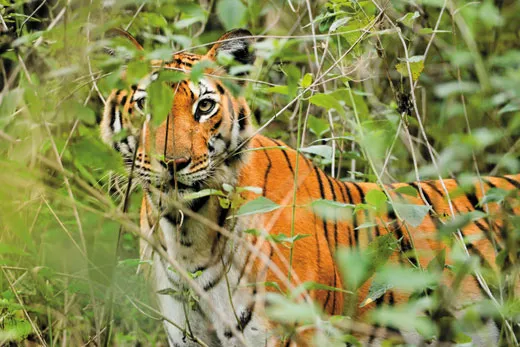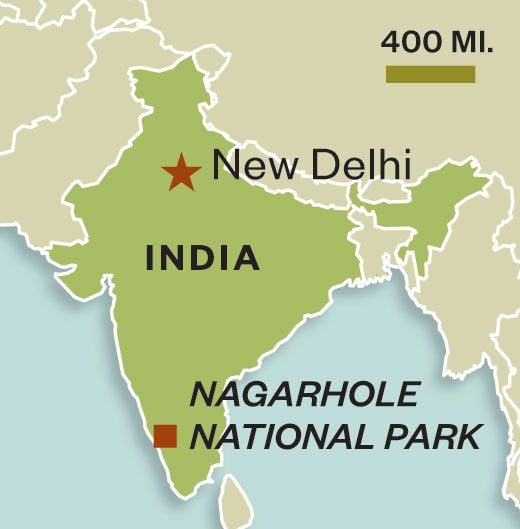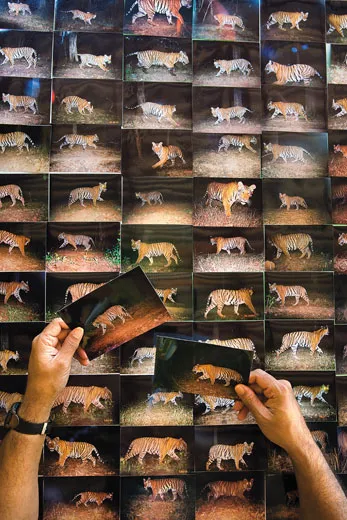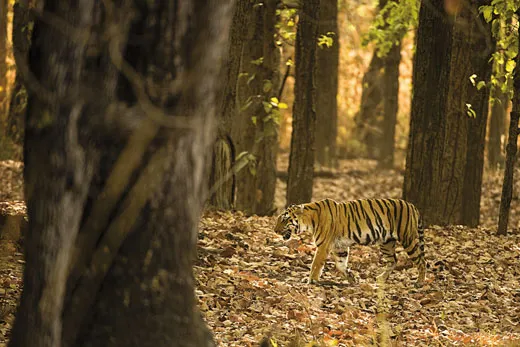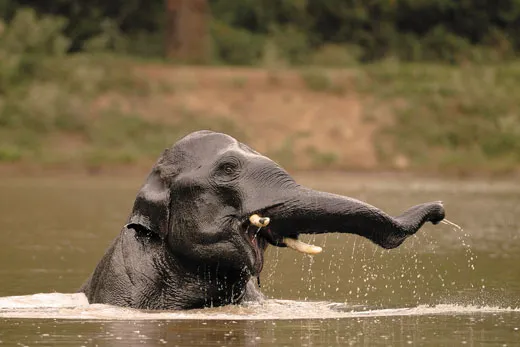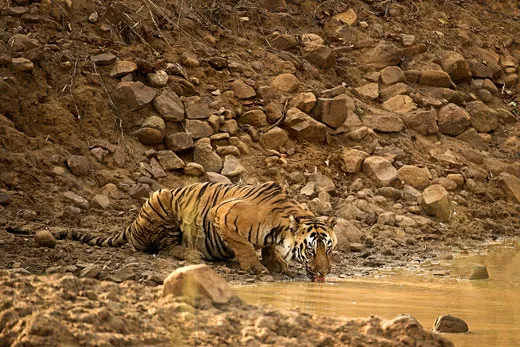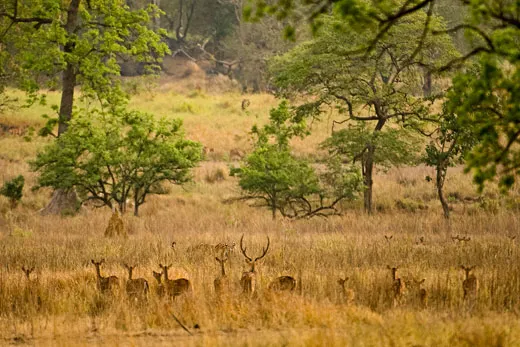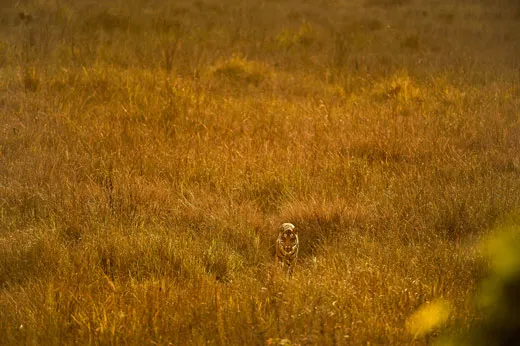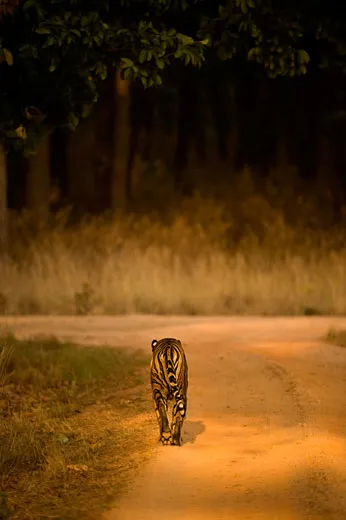The Fight to Save the Tiger
“It’s a sign saying, ‘I am here! I am here!’ ” says Ullas Karanth as he flails his arms and jumps up and down in a mock attention-grabbing wave.
He is referring to a scrape, a patch of jungle floor recently cleared by a tiger’s hind paws. It’s huge, the size of a cafeteria tray. Based on the freshness of the uprooted grass along the edges, Karanth figures a tiger passed here sometime last night. I kneel down and am hit by an overwhelming stench—the musky spray of a quarter-ton cat that has just marked its territory.
Signs of tigers are everywhere inside Nagarhole National Park in southwestern India. From our forest service lodge we hear the telltale alarm calls of deer in the middle of the night. On early morning drives Karanth, one of the world’s leading tiger biologists, points out paw prints the size of dinner plates. We pass trees with trunks that the cats have raked bare, signposts for rivals and potential mates.
Karanth has deep piercing eyes that can spot a deer a quarter of a mile away from inside a moving vehicle. He prefers, however, to drive with his head sticking out the window so he can read the tracks of every animal that has crossed the path beneath our wheels. Gleefully calling out each animal by name, he seems oblivious as the vehicle swerves alarmingly from side to side.
After days of searching through forests that harbor some of the highest concentrations of tigers in the world, we have yet to see one. Karanth tells me he spent 15 years looking before he saw his first wild tiger. Even when the cats are all around, he says, the odds of seeing one are slim.
A few days later, driving down a dirt lane in neighboring Bandipur National Park, we come across a jeep operated by a local tour company. Bandipur has fewer tigers than Nagarhole, but its dry, open forests make for easier wildlife viewing. The jeep has stopped and its passengers are staring intently. As Karanth pulls up behind them I see stripes of orange, black and white. “Tiger!” I yelp.
One of nature’s most perfect killing machines dozes in the afternoon heat. We watch the cat sleep as other jeeps crowd around us like a pack of dholes, the wild dogs that hunt inside the park. People gasp and point, then click their cameras from the safety of their vehicles. Slowly, the tiger opens one eye, and with a casual glance in our direction, locks me in a gaze so powerful that all else disappears. After licking its paws and stretching its back, the cat rises to its feet. Then the tiger turns its head and walks deeper into the forest until it disappears.
From the boreal forests of the Russian Far East to the jungles of Sumatra, tiger populations are in free-fall. In the past century, their numbers have plunged from an estimated 100,000 to fewer than 3,500.
This small pocket of southwestern India is one of the few places where the tiger popula- tion has reversed the trend and is now strong. Biologists and government officials from all over the world are visiting Nagarhole to learn from Karanth; he gives them hope that they can save their own tigers and other big cats.
Karanth, 63, grew up less than 100 miles from here and first visited Nagarhole (also known as Rajiv Gandhi National Park) in 1967 as a teenager. Hunting and logging were rampant in the park at the time. Seeing even a chital, the small spotted deer now found in droves throughout the park, was rare. “I was pretty sure I would never see a tiger by the time I grew up,” he says.
Karanth went on to study mechanical engineering and then bought a plot of land to farm near Nagarhole so he could be an amateur naturalist in his spare time. In 1984, he entered a wildlife management training program at what is now the Smithsonian Conservation Biology Institute in Front Royal, Virginia. Karanth earned a PhD from Mangalore University studying tigers inside Nagarhole. He now works for the New York-based Wildlife Conservation Society (WCS), combining the cool objectivity of an engineer with the passion of a local boy who never tired of looking for tigers. Since he began monitoring the population in 1990, tiger numbers in Nagarhole have climbed from fewer than 10 individuals to more than 50. More important, the park is a source of young tigers: Cubs born here are leaving the park and repopulating the surrounding forests. “There are now 250 tigers in this region,” Karanth says. “If we do everything right, we can have 500.”
“You have to be able to measure tiger populations with confidence, and Karanth has developed the whole tool kit to do this,” says John Seidensticker, head of the Smithsonian’s Conservation Ecology Center and one of Karanth’s early mentors.
Each year after the summer monsoons, Karanth and his team blanket the forest with hundreds of camera traps. When an animal walks past a trap, infrared sensors trigger cameras on both sides of the trail. Every tiger has a unique stripe pattern, which Karanth uses to identify individuals and estimate how many tigers live in Nagarhole at any time. He has collected more than 5,000 tiger photographs.
He has found that one out of four adult tigers in the park dies or disperses into the surrounding forest each year. In the past four years, he says, he documented 40 deaths in the area that includes Nagarhole, Bandipur and several other reserves. But he’s not worried. “If reproduction is up,” he says, “this is not a problem.”
What affects tiger reproduction? The answer might seem simple, but it took Karanth nearly ten years to collect the data to confirm a direct relationship: The more animals available for tigers to eat, the more they reproduce. “The forests were empty not because the tiger had been hunted out, but because their prey had been,” Karanth explains.
The realization has significant implications for how to protect tigers. Many conservation authorities focus on stopping big-game poachers, who kill tigers and sell the body parts for high prices on the black market. (Tiger bone, for instance, is promoted as a cure for arthritis and malaria.) But Karanth’s findings suggest that local villagers who hunt deer and other animals have had a larger impact than wildlife traffickers on tiger numbers. Now 120 men, armed with little more than sticks, patrol Nagarhole looking for illegal snare traps.
Early one morning, Karanth and I left the safety of a WCS work jeep and stepped into an environment where humans aren’t at the top of the food chain. A splotch of red paint on a tree marked the start of a two-mile trail we would follow through the forest looking for wildlife. Even the smallest noise or movement sent me jumping.
Karanth scouted straight ahead while WCS technician M.N. Santosh followed a few paces behind, looking for movement on either side. The biologists are armed with nothing more than a clipboard, a compass and a range finder (a glorified laser pointer for determining how far away something is). Based on the number of animals they find and their distance from the path, the biologists can estimate prey densities.
I struggle to keep up, trying not to snap any branches beneath my feet. My effort to tread lightly is partly so I don’t scare off any animals and skew their survey results. It’s also self-preservation. Nagarhole is home to one of the highest concentrations of forest-dwelling Asian elephants. The giant pachyderms have poor eyesight, are easily spooked and can charge through the forest faster than any human can run. Roughly 30 people die each year in the region as a result of elephant tramplings. Tigers, in comparison, have killed two or three here in the past 45 years.
Ten minutes into our hike, I step ankle-deep in dung so large it could come from only one animal. Something large crashes through the brush a short distance away. “Elephant!” Karanth whispers with a glint in his eyes that seems more mischievous than worried.
Then a second elephant trumpets an alarm call and the slight smile on Karanth’s face vanishes. He comes closer and whispers in my ear, “We’ll be fine, but if anything happens, scatter and follow the line back to the jeep. This is the backup plan.”
We pause for a moment that seems like an eternity, then quicken our pace down the trail. We make it through the forest unscathed but see a potential tiger buffet, including six chital deer, a dozen monkeys and three gaur, the largest wild cattle on earth.
Over the next few months, Karanth, Santosh, other WCS staff and a rotating cast of 150 volunteers will hike more than 3,000 miles through the forest counting prey. Karanth estimates that prey animals currently represent 20,900 pounds of food per square mile, a smorgasbord for the park’s tigers, leopards and wild dogs.
The animal abundance hasn’t come from anti-poaching patrols alone. Strict wildlife-protection laws forbid hunting, logging and the sale of forest products. And since the 1990s, the government has offered a voluntary relocation program to tribal groups living in the park. People willing to move are given a house, a hectare of land and access to health care facilities and schools that aren’t available within the park.
“Relocations have to be voluntary, they have to be incentive-driven, and there has to be no element of force,” Karanth says. “If they are done badly, they give a bad name to conservation and no one is happy. But if they are done well, it’s a win-win situation for people and wildlife.”
In addition to his groundbreaking fieldwork, Karanth has spent countless hours fighting legal battles to protect tiger habitat from encroaching development. “To me the real issue is this landscape with roughly ten million people and a sustained economic growth rate of 10 percent; if you can protect tigers with all of that, that augurs well for the species’ future.”
Karanth’s success has attracted widespread interest. In 2006, Panthera, a conservation organization dedicated to protecting wild cats, teamed up with WCS to implement Karanth’s conservation practices at several other sites in Asia. The project, known as Tigers Forever, is modeled on the intensive monitoring and rigorous anti-poaching patrols in Nagarhole.
The goal for each site is to increase the cat’s population by 50 percent by 2016. Sites in Thailand are beginning to show promising results, and programs in Malaysia, Indonesia, Laos and Myanmar are getting underway. India is moving toward adopting Karanth’s intensive monitoring approach in tiger reserves nationwide. (This year Karanth won the Padma Shri, a prestigious award presented by the president of India.)
In the forests of southwestern India, the tiger’s future looks promising. Rounding a corner on a drive through Nagarhole, we come across two gaur bulls squaring off in the middle of the road. The animals stand with legs firmly planted, ruddy-brown mountains snorting in the late afternoon sun.
The younger of the two bulls tries to assert his dominance by showing off a large shoulder hump that towers over the older male. On rare occasion, gaur bulls will lock horns in fierce territorial battles, a scene depicted on every can of the popular energy drink Red Bull. For the moment, the hulking creatures circle and strut.
A short distance ahead, a herd of 50 chital feed in a clearing where a human settlement once stood. Looking out on the deer—a year’s food supply for an adult tiger—Karanth can’t help but smile. “When I was young there was no hope,” he says. “Today there is a lot of hope.”
Phil McKenna wrote about Tibetan buntings in the October 2011 issue. Wildlife photographer Kalyan Varma is based in Bangalore.
